
| Station Name: WIGSTON MAGNA |
 |
[Source:
John Stevenson]
| Date opened: |
8.5.1857 |
| Location: |
At the road bridge on the south side of Station Road (B582) on the western edge of Wigston Magna. |
| Company on opening: |
Midland Railway |
| Date closed to passengers: |
1.1.1968 |
| Date closed completely: |
1.1.1968 |
| Company on closing: |
British Railways (London Midland Region) |
| Present state: |
All evidence of the station has been removed, although it is possible to detect where the now bricked-up entrances to the platforms were in the walls of the overbridge. The Midland main line continues to carry both passenger and freight |
| County: |
Leicestershire |
| OS Grid Ref: |
SP595985 |
| Date of visit: |
1.4.2012 |
Notes: The first station on this site was built as the result of the Midland Railway (MR) constructing their direct line to London, initially via Hitchin and the GNR to Kings Cross. This new route commenced just north of the station where it diverged from the line to Rugby at Wigston North Junction. The MR sited their new station just south of the level crossing on the road from Wigston to Blaby.
 |
The design of the first station was distinctive and attractive, strongly resembling the buildings at neighbouring Great Glen and Kibworth and the other Leicester to Hitchin stations – some of which survive. Built by C H Driver in a Victorian Gothic style, on the ‘up’ platform the two-storey stationmaster’s house was in red brick and featured a steeply pitched slate roof |
with elaborate bargeboards and spiked finials. Dentillation was added under the eaves. The entrance to the station house from the forecourt was through a gabled porch, set at an angle. Window openings were generally paired and round-headed in polychrome brick. In contrast to the station house, whose long axis was at right angles to the platform, the attached single-storey office range, which contained the ticket office and waiting rooms was aligned with the platform and set back from the house. It was fronted by a waiting shelter, with a double ridge-and-furrow roof, half of which was enclosed by a brick wall, pierced by paired windows with lozenge-shaped leaded lights – a feature of the windows elsewhere on this station. It is possible that a waiting shelter was provided on the opposite platform, and, if so, it would probably have been of a complementary ridge-and-furrow roofed design which is known to have existed at nearby Great Glen and Kibworth stations. A signal box was positioned at the level crossing on the west side of the line. There was a small goods yard with limited facilities.
| This was the second station to serve the village of Wigston, the first being built in 1840 by the Midland Counties Railway just a few hundred yards to the west on their original route to Rugby. For over a decade both stations were identified simply as Wigston, but in 1868 the MR renamed the first Wigston South, and the more recent Wigston (L&H). This was because the |
 |
official name for the new route to London had been the Leicester & Hitchin Railway, although by 1868 the MR had just opened its own direct route into St Pancras station. Nonetheless, L&H was adopted for the MR station on the new main line at Wigston, although this name only ever appeared on tickets at the time. The station nameboards continued to show ‘Wigston’ and, even more confusing, the timetable entries never referred to this station as L&H – just Wigston.
 |
The one exception to the latter was between 1875 and 1900, when the MR introduced a direct coach service on some trains from London and Northampton to Birmingham, via Wigston. The construction of a south curve at Wigston in 1872, connecting the MR mainline to the recently built South Leicestershire Railway (SLR) from Nuneaton to Leicester, was primarily |
intended for goods traffic, but it also opened up the possibility of a passenger service. It seems that the MR never considered that there was sufficient demand for specific timetabled trains, but they did try to tap into the market by offering a direct coach service towards Birmingham from the south. A single coach (or possibly more than one at peak times) would be detached at Wigston from the rear of a train from London or Northampton, and most likely propelled around the south curve to be attached to the rear of a MR scheduled Leicester to Birmingham passenger train just before Glen Parva Junction with the SLR. This service appears to have lasted for about 20 years, during which time the MR timetables referred to Wigston as the 'Junction for Birmingham'.
This service was withdrawn just before the turn of the century, quite possibly at the same time as Wigston(L&H) station was redeveloped. Traffic on the double-track main line to London and the south had increased to such an extent that the MR decided to widen the route south of Leicester with the addition of parallel freight-only lines as far as Kilby Bridge, just to the south of Wigston. To remove the bottleneck of the level crossing at Wigston, a bridge was put in to take the Wigston to Blaby road over the railway. This necessitated rebuilding the station at Wigston, work which became very protracted, taking nearly two years to complete. All goods facilities were withdrawn from 1 January 1902 an the new station was opened on 22 September 1902.
| The existing platforms were retained, but raised, and the new freight tracks passed the back of each platform behind the buildings and the typical ‘diagonal’ Midland fences. The new structure was much more substantial in size, with access to the platforms from the road overbridge. Each platform had a large, austere brick building with a pitched roof, and flat awnings with |
 |
decorated valances. The waiting rooms and toilet facilities were in the platform buildings, but the ticket office was situated at road level at the entrance to the 'down' platform. This was a sturdy and substantial brick building with several prominent gables and segmental-arched windows. The entrance was set forward towards the road from the main building, enlivened by ball finials and with ‘MR Wigston Station’ named in terra-cotta mouldings. Cantilevered over the tracks to the east of the office building was a glazed entrance hall in timber, from which covered stairways led down to each platform. The new house for the stationmaster was built north of the adjacent terrace of railway cottages.
It was not until 2 June 1924 that the station was once more renamed. Still officially recognised as Wigston (L&H), the LMS took the decision to identify the station as Wigston Magna, which more accurately reflected the name of the adjacent village. This time, the LMS changed the platform nameboards, as did British Railways in the late 1950's when the totem signs and vitreous enamel nameboards were introduced.
 |
Wigston Magna became the predominant of the three Wigston stations, although its train service by 1950 was limited and irregular. By the mid 1950s few trains called outside morning and evening rush hour. The neighbouring Wigston South closed in 1962, and the other two were earmarked for closure in the Reshaping of British Railways (‘Beeching’) report of |
March 1963. On 24 September 1964 Wigston Magna and the other stations served by local trains between Leicester and Wellingborough were formally proposed for closure, and the report on the hearings of the Transport Users’ Consultative Committee was presented to the Minister of Transport on 28 October 1965. The March 1967 timetable showed a service of only four weekday trains in each direction calling at Wigston Magna, still confined to morning and evening rush hour, plus a midday train each way on Saturdays only; no trains called on Sundays. After some delay, on 31 August 1967 the closure of Wigston Magna and three other stations between Leicester and Wellingborough was approved, and closure took place on 1 January 1968.
Further reading: Leicestershire's stations by Andrew Moore (Laurel House 1998).
See also: Wigston South and Wigston Glen Parva
See also Wigston Motiver Power depot |
magna_old1.jpg) Wigston (L&H) station looking north towards Leicester c.1885. The signal box on the west side of the line controls the level crossing.
Photo
from John Stevenson collection

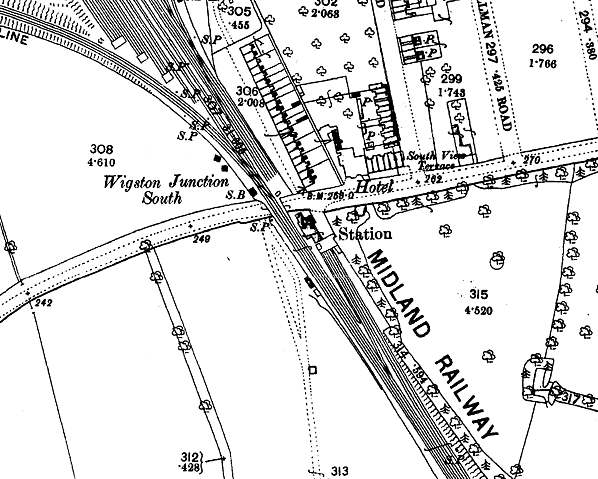
1886 1:2,500 OS map showing the original layout of the station.
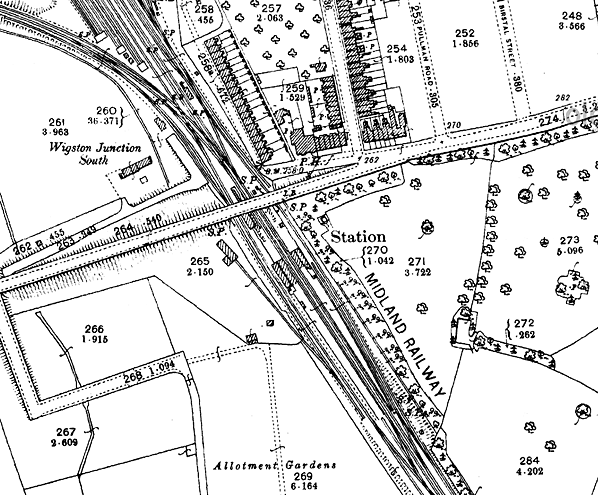
1904 1:2,500 OS map showing the station after rebuilding in 1902. What appears to be a goods shed is seen on the left. Goods facilities were withdrawn from the station on 1 January 1902.
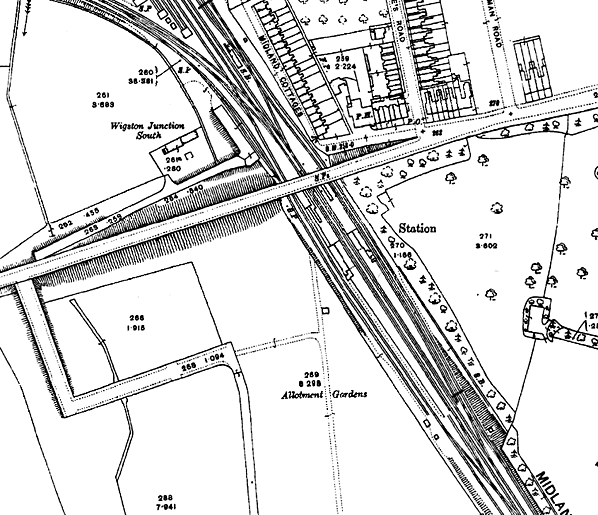
1914 1:2,500 OS map. The goods shed and siding have now been removed.
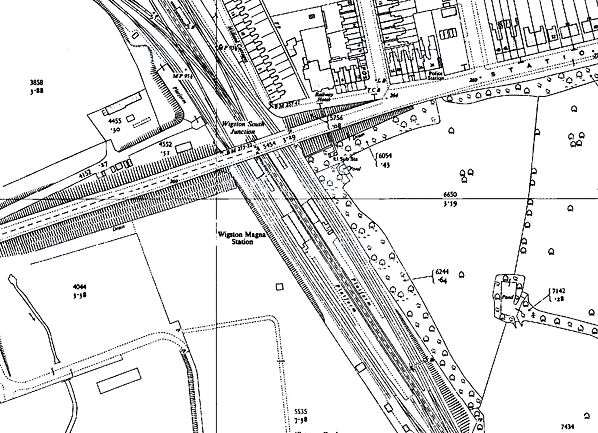
1955 1:2,500 OS map. The station is now shown as Wigston Magna.
Wigston (L&H) c.1900 just prior to being rebuilt. Note that the signal box has been moved to the east side of the level crossing.
magna_old3.jpg)
The new station c.1912 with a MR express on an up train for London. Note the level crossing has now been replaced by a bridge.
Photo
from John Stevenson collection
magna_old10.jpg)
Wigston Magna station looking south from Station Road bridge in LMS days.
Photo
from John Mann collection
magna_old4.jpg)
The station frontage at road level in October 1952. The entrances to the two covered stairways down to the platforms are seen on the left.
Photo
from John Stevenson and John Alsop collections
Looking north from the up platform in 1961. The ‘Sugg’ gas lamp on the right is mounted on its older standard in the typical LMR fashion. The totem name sign would have been installed in 1957, or later.
Photo
from John Stevenson collection and copyright Stations UK
magna_old9.jpg)
An early morning class B, local passenger train hauled by 44575 pulls into the down platform to collect passengers for Leicester in 1961. This loco was built at Crewe works in September 1937 to a Fowler design of 1922 for the Midland Railway. One of a class of 772, this 4F, 0-6-0 had a working life of just over 27 years when it was withdrawn from Coalville shed in November, 1964 and cut up by Cohens of Kettering in February 1965.
Photo
from John Stevenson collection
magna_old7.jpg)
A local passenger train for Leicester in 1963. This train is a light load for this BR Standard class 4, 4-6-0 loco. Designed by R.A. Riddles and built at Swindon works, 75063 entered service in June 1957 at 16A, Nottingham shed. Following a move to Derby in 1962 and Nuneaton in 1963, this loco was withdrawn from Shrewsbury shed in May 1966 after less than 9 years in service, and cut up in August of that year by Birds of Long Marston.
Photo
from John Stevenson collection
south_old16.jpg)
A southbound 'Blue Pullman' passing through Wigston Magna station in the early 1960s.
magna1.jpg)
An East Midlands Trains 222 'Meridian' unit passes the site of Wigston Magna station on a down train from London in April 2012.
Photo
by John Stevenson
magna2.jpg)
Nothing now remains of the station frontage at road level except the two bricked up entrances. Compare with the 1952 picture above .
Photo
by John Stevenson
Click on thumbnail to enlarge
| Last
updated: Friday, 26-May-2017 10:02:16 CEST |
© 1998-2012 Disused Stations
| |

magna_old1.jpg)





magna_old2.jpg)
magna_old3.jpg)
magna_old10.jpg)
magna_old4.jpg)
magna_old8.jpg)
magna_old9.jpg)
magna_old7.jpg)
south_old16.jpg)
magna1.jpg)
magna2.jpg)


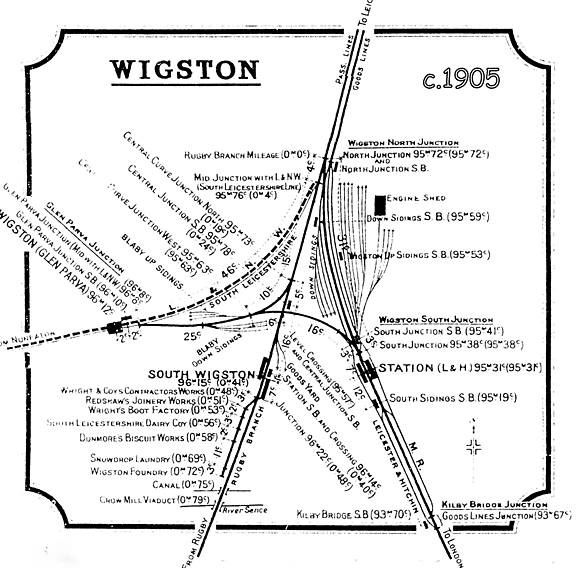


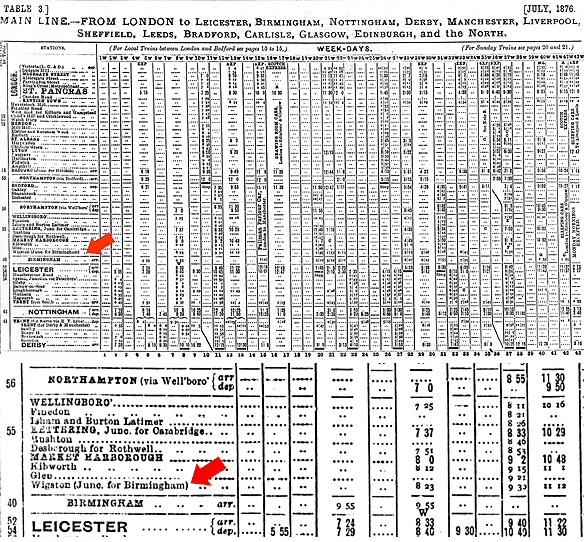


south_old_thumb14.jpg)
south_old_thumb15.jpg)
magna_old_thumb6.jpg)
south_old_thumb10.jpg)
south_old_thumb9.jpg)
south_old_thumb11.jpg)
south_old_thumb13.jpg)
south_old_thumb12.jpg)

 Home Page
Home Page